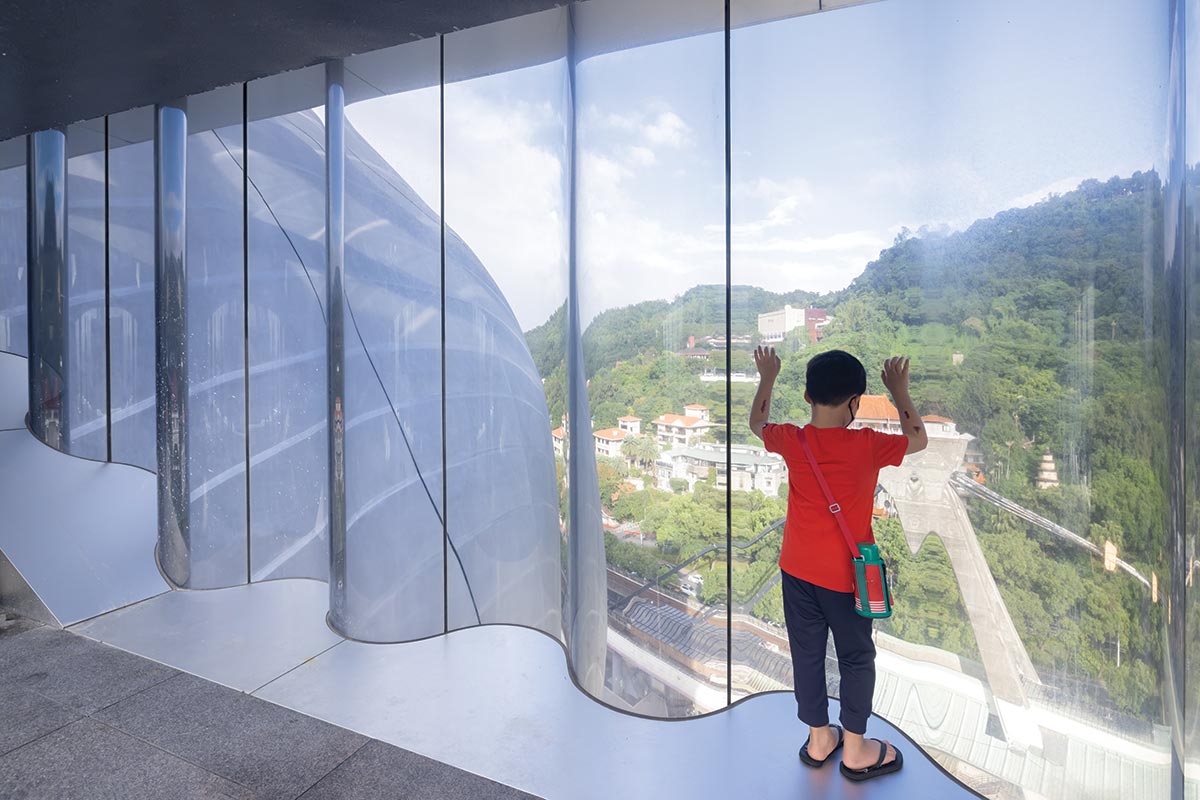Arts & Culture
Learning Objectives:
- Describe the challenges involved in building in dense and historically sensitive urban areas and outline possible construction approaches.
- Explain the design factors that determine a performance hall’s quality of sound, including size, configuration, and materials.
- Discuss innovative cladding strategies, including those for glass facades and terra-cotta rainscreens, and describe the digital-design technologies and the fabrication methods that allow them to be realized.
- Describe shading techniques for glazed facades that can achieve striking visual effects while mitigating glare and heat gain.
Credits:
This course is approved as a Structured Course
This course can be self-reported to the AANB, as per their CE Guidelines
Approved for structured learning
Approved for Core Learning
This course can be self-reported to the NLAA
Course may qualify for Learning Hours with NWTAA
Course eligible for OAA Learning Hours
This course is approved as a core course
This course can be self-reported for Learning Units to the Architectural Institute of British Columbia
View course on architecturalrecord.com »
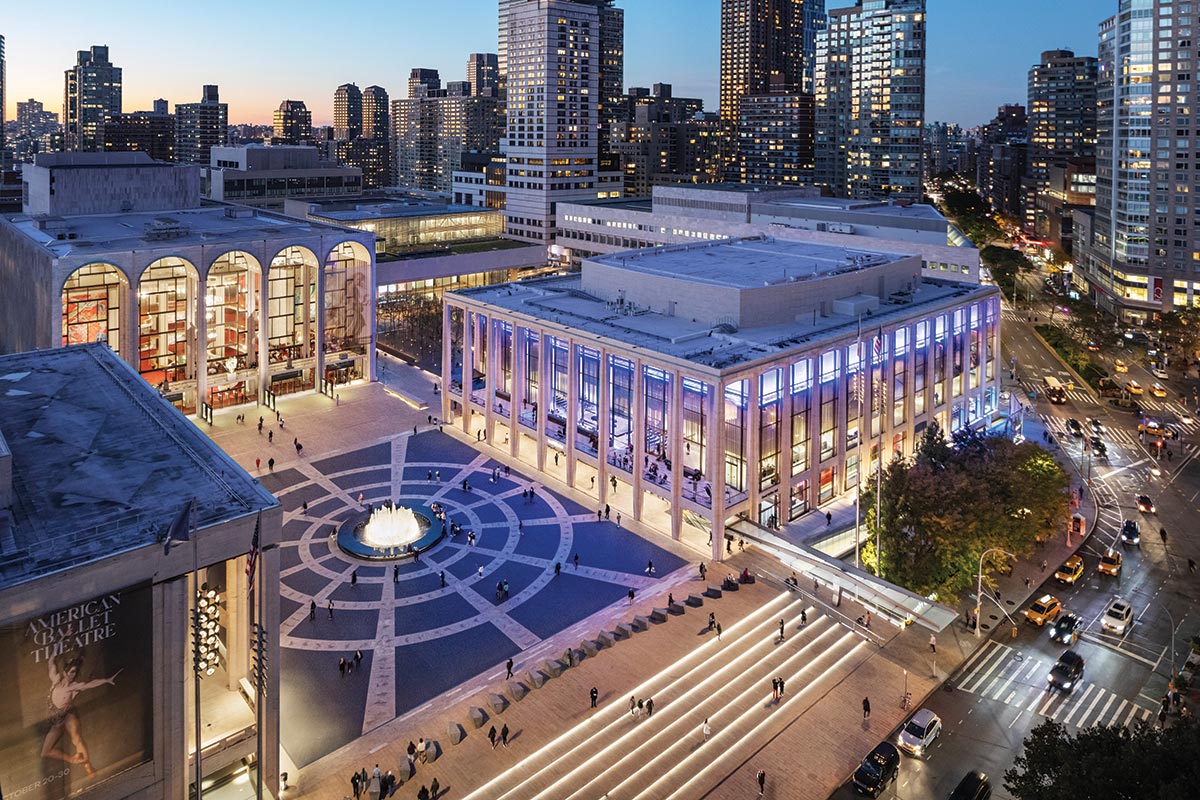
Photo © Michael Moran
David Geffen Hall.
From a Rem Koolhaas-designed theater in Taipei to a site-sensitive museum in California, this month's arts and culture projects push the boundaries of architecture with dramatic forms, complex constructions, and challenging contexts.
OMA’s Taipei Performing Arts Center floats above the city, promising new possibilities for the making of theater.
BY IZZY KORNBLATT
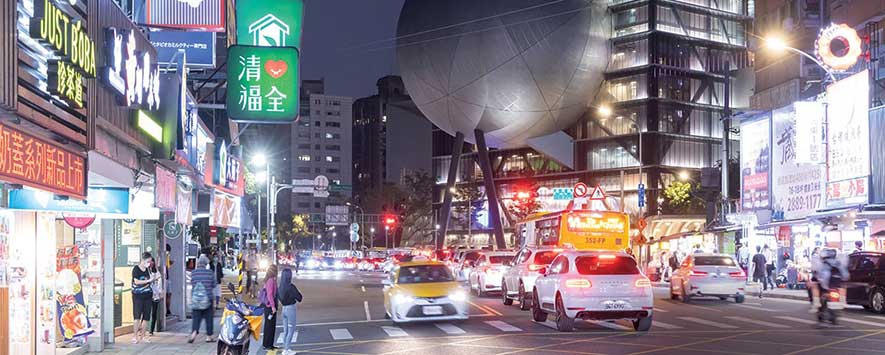
Photo © Iwan Baan
Taipei Performing Arts Center.
THE ARCHITECT Kazuo Shinohara once observed that some of the most advanced machines in the world—fighter jets and spacecraft—do not conform to refined modern aesthetics. Their parts appear “clumsily joined together,” he wrote in a 1981 essay, lacking in “elegance from an architectural standpoint.” But in these machines’ refusal to cover up messiness with a veneer of beauty, Shinohara found the promise of a revelatory architecture: building as ungainly machine.
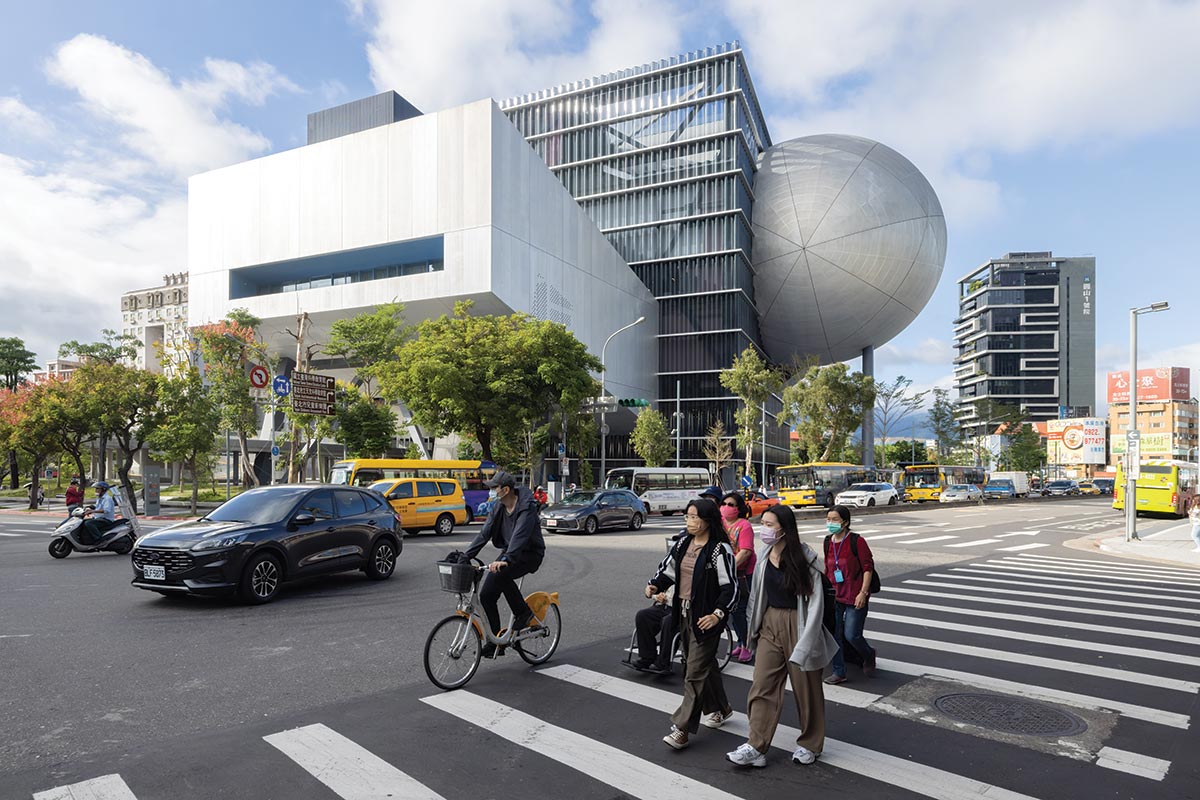
Photo © Iwan Baan
Located at a major intersection, TPAC commands attention despite the city’s vibrant lights and signs (top).
The Taipei Performing Arts Center (TPAC) comes as close as any contemporary building to embodying Shinohara’s vision. Designed by an OMA team led by partners Rem Koolhaas and David Gianotten and project director Chiaju Lin, with the Taiwan-based firm KRIS YAO | ARTECH, the center was first proposed in 2008 for a site in the city’s Shilin district and is now complete, after a tortured construction process marked by the general contractor’s bankruptcy. The building takes the form of a 10-story glass cube from which three aluminum-clad volumes—a rectangular prism, a wedge, and a slightly distorted sphere—protrude awkwardly, supported by long columns that touch down on a sweeping plaza below. In order to unlock the near limitless range of possible configurations and uses dreamed of by performers, the architects have pulled three theaters out of the cube—or, rather, crashed them, stage-first, into the cube, enabling the stages and backstage areas to be joined in various ways. Two of the three—a 1,500-seat proscenium theater with conventional raked seating (the wedge) and an 800-seat flexible “blue box” (the prism)—can become a single, enormous space when partition walls are moved, a feature that proved useful for runway shows during Taipei Fashion Week. The third, an 800-seat “globe” that is naturally housed within the sphere, can expand into a backstage rehearsal room.
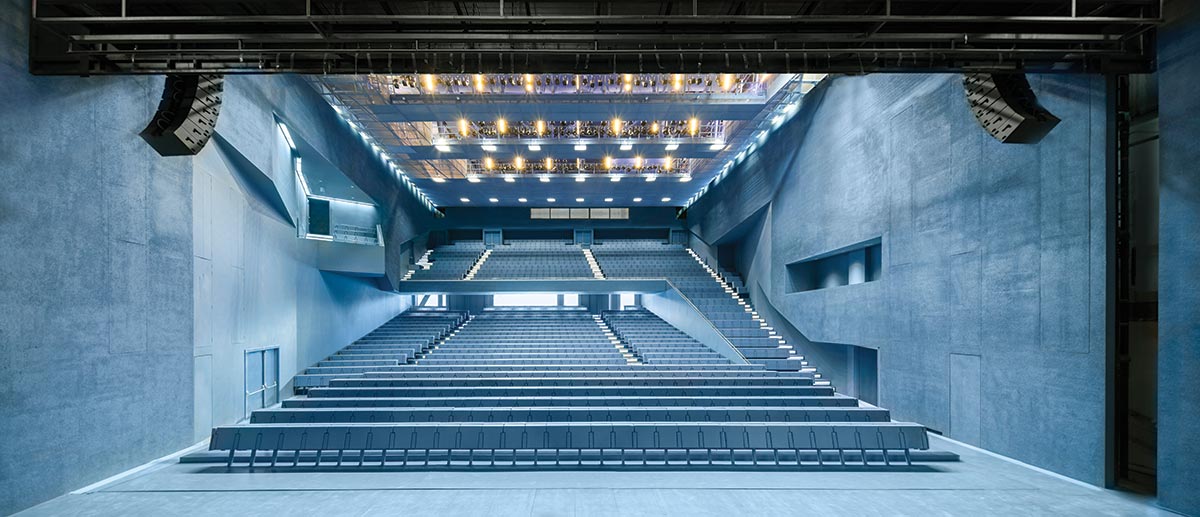
Photo © Iwan Baan
The 1,500-seat grand theater projects from TPAC’s south face.
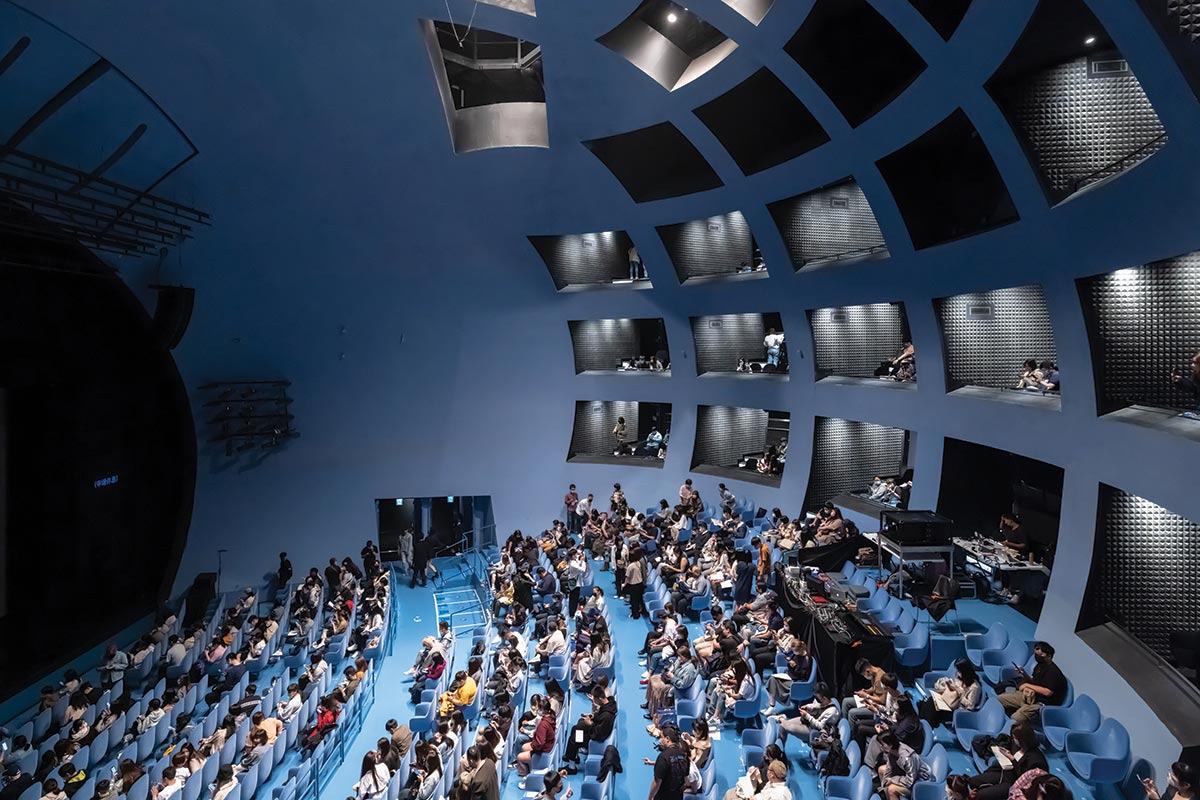
Photo © Iwan Baan
An 800-seat theater is housed within the spherical protrusion.
In its ingenious flexibility, TPAC takes its place within a history of OMA’s investigation of the theater—from one of Koolhaas’s first built projects, the Netherlands Dance Theater in the Hague (1987) to the Wyly Theater in Dallas (RECORD, February 2010)—and that of the firm’s pursuit of architecture that can be transformed by its users. “I find it difficult as an architect to be specific, because each specificity excludes or kills other possibilities,” says Koolhaas. By enabling the theaters to be combined, “we were able to offer both specificity and an alternative to specificity.”
Beyond the diagram of three floating theaters surrounding a core, another, less obvious one is at work: that of a “public loop” that winds its way from the ground floor to a top-level viewing platform and down again, passing by various front- and back-of-house spaces along the way. Within the loop’s darkened spaces, members of the public gaze through apertures that afford sometimes voyeuristic views of theater in the making. The loop culminates in a curved black room above the globe from which observers can catch a glimpse of rehearsals or performances, and here the building’s second theme emerges: the demystification of theater. This theme is also evident in the building’s unusually welcoming sequence of public spaces, which pulls visitors from the plaza through a three-level lobby that remains open throughout the day, and in theaters that are utilitarian, rendered matter-of-factly in blue, with no trace of pomp or deep-red luxury. Throughout the interiors, the processes of construction and operation are revealed, from the fireproofed steel structure that threads its way around the central cube (enabling the long spans needed within the theaters) to OMA’s familiar unpainted drywall. The loading docks are raised to the second floor, via a concrete ramp, placing oft-hidden logistics on public display. And the cube’s undulating glass facade (see sidebar, this page) becomes a distorted lens through which backstage spaces are revealed—and through which outward views of the city become equally theatrical.
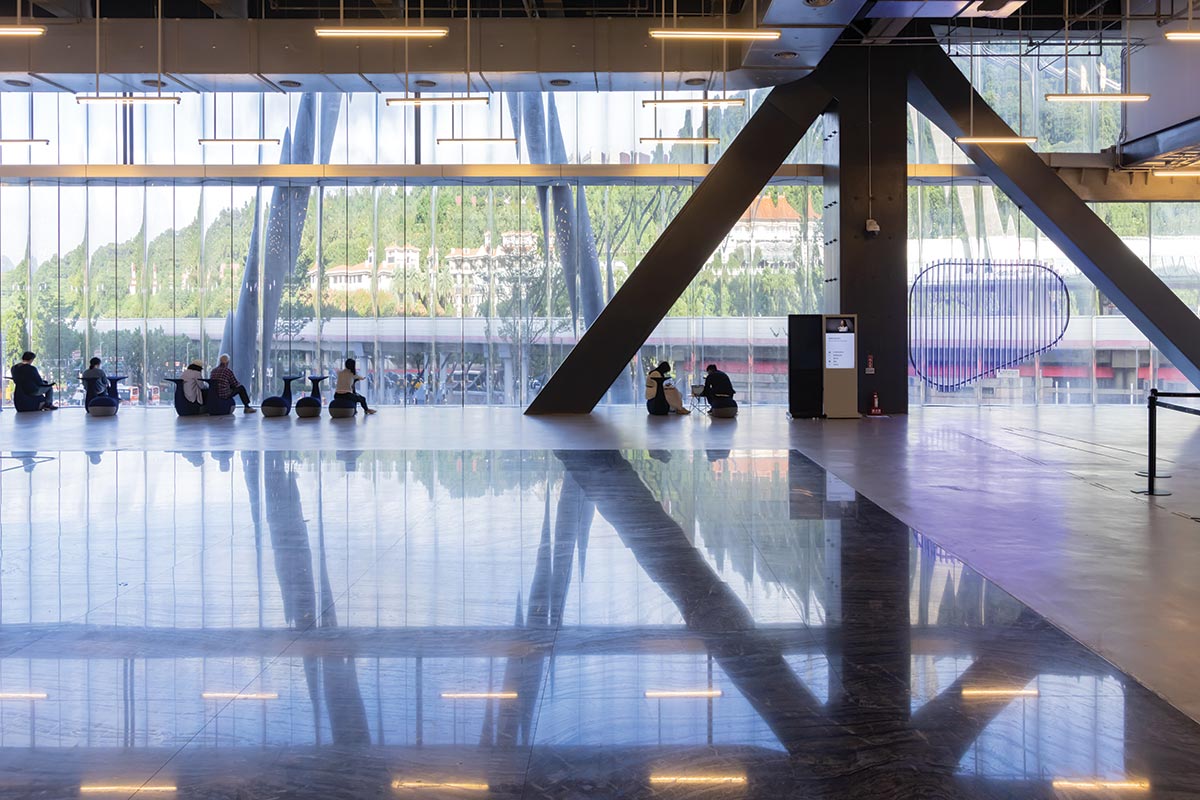
Photo © Iwan Baan
A sequence of public spaces, including the multilevel lobby (above), pulls visitors from a plaza (below) into the building.
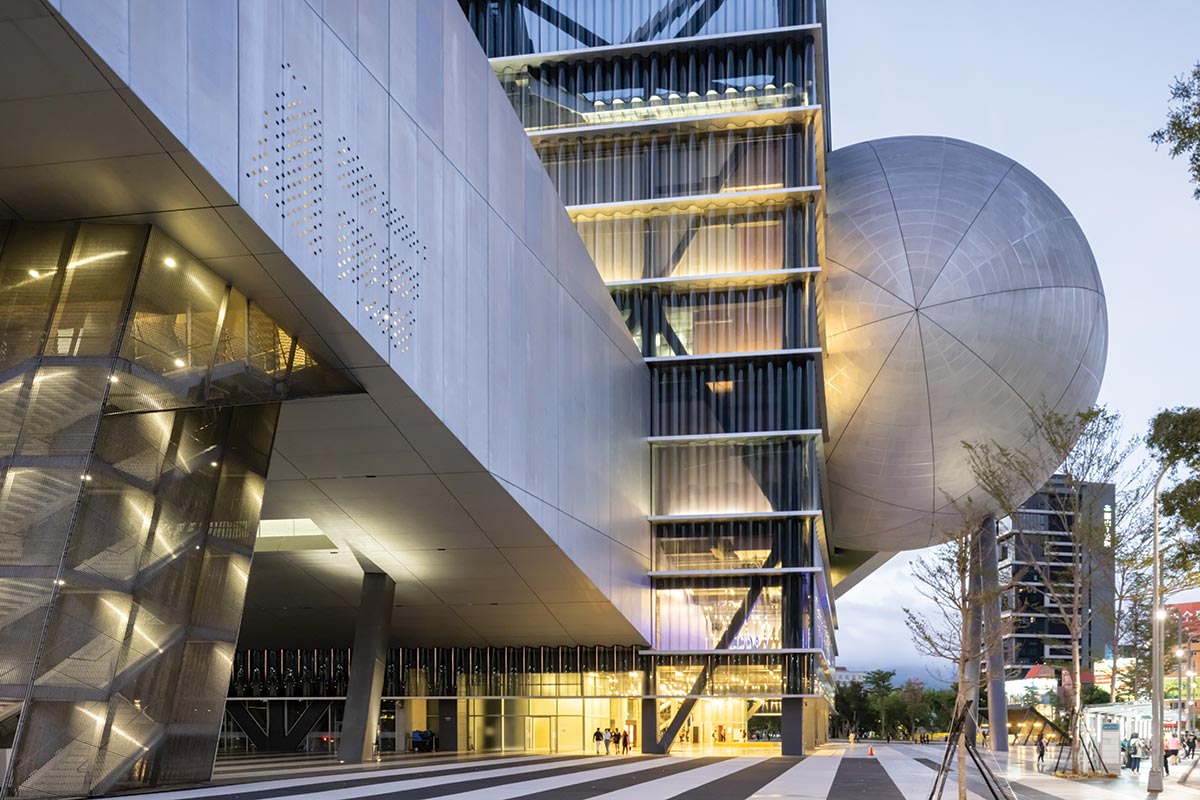
Photo © Iwan Baan
“There have been a few moments where we tried to articulate a theory in a building—where we tried to address the issue of the maximum you can achieve” given practical constraints, says Koolhaas, and most remain unbuilt. “This is part of that sequence, with those ambitions, but built.”
Koolhaas, ever transgressive, initially proposed lifting the three theaters in order to enable the site’s previous occupant, the informal, boisterous stalls of the Shilin Night Market, to continue operating in their shadow. Political concerns nixed this idea—the market was instead moved nearby—but OMA’s concept retained its provocative undermining of hierarchies. As a work of “good sabotage,” in the words of ARTECH founder Kris Yao, TPAC questions theater’s inflated social status and the luxe architecture that typically supports it.
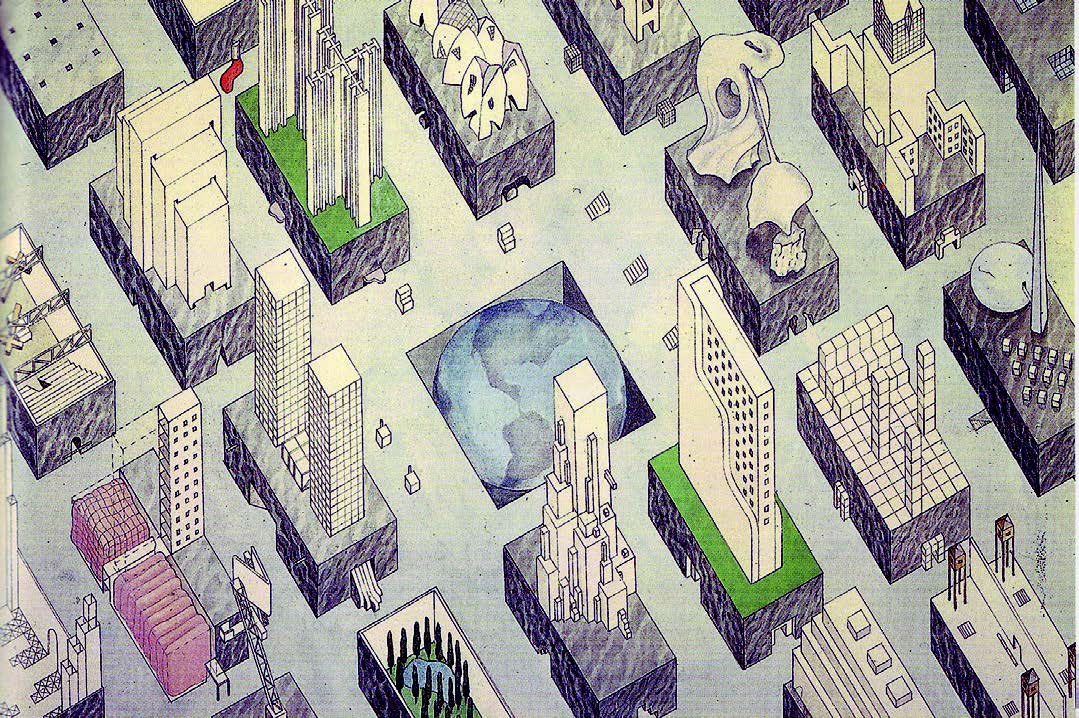
Illustration © Rem Koolhaas with Zoe Zenghelis, courtesy OMA
Spheres have been a leitmotif for Koolhaas at least since his 1972 “city of the captive globe” speculative project.
One way the building inverts hierarchies is in speaking the language of the city. In Taipei, everyday life is made visible through architecture: like a “chaotic Tokyo,” as Lin describes it, the city is crammed full of signs, lights, and banners that compete happily for attention. Standing tall over a major intersection, an elevated metro station to one side with mountains just beyond, and a set of narrow lanes branching off across the street, TPAC embraces Taipei. Its disjointed forms seem always to be in motion, as if jostling with the dense crowd of buildings. Each of its faces is distinct, but what most visitors will remember is Koolhaas’s looming aluminum globe, a sphere within the urban labyrinth easily visible from afar. Spheres have been a leitmotif for Koolhaas at least since his speculative 1972 project “city of the captive globe.” And in Delirious New York, his mythic 1978 manifesto, he comments that the appearance of spheres in Western architecture coincides “with revolutionary moments” in history.
Taiwan today—a democracy with a potent counterculture that has emerged both in spite of and because of the perpetual threat of a Chinese invasion—seems fittingly revolutionary.
But whereas most of Taipei is filled with explicit symbols, this building is signless and mute, a machine whose parts are made visible but refuse to speak. As a result, TPAC has become a subject of widespread interest in a way that now seems rare for architecture. What, the public asks, could these strange forms mean? Some call it huaji, or comical, on account of a popular theory that each of its volumes represents a different Taiwanese food often sold in night markets. Others compare it to the popular dish of preserved duck egg with tofu. And TPAC has sought to explain the building by likening it to three-broth hot pot. The battle of culinary metaphors has become a way of collectively making sense of architecture—“a way of digesting it,” in Koolhaas’s apt phrase—and the building has itself become a kind of public performance; its abstract forms, like the costumed dancers of Oskar Schlemmer’s Triadic Ballet, tempt observers to interpret it through their own cultural lenses.
At TPAC, then, the show begins long before the theater doors are open. It begins even before trucks arrive at the stagelike loading docks or the public loop fills with visitors. Here, everything, from seeing the city through distorted glass to interpreting the architecture, becomes a matter of performance and observation. Once the elitist box circumscribing the art of theater is torn away, theater is freed to enter into every aspect of life.
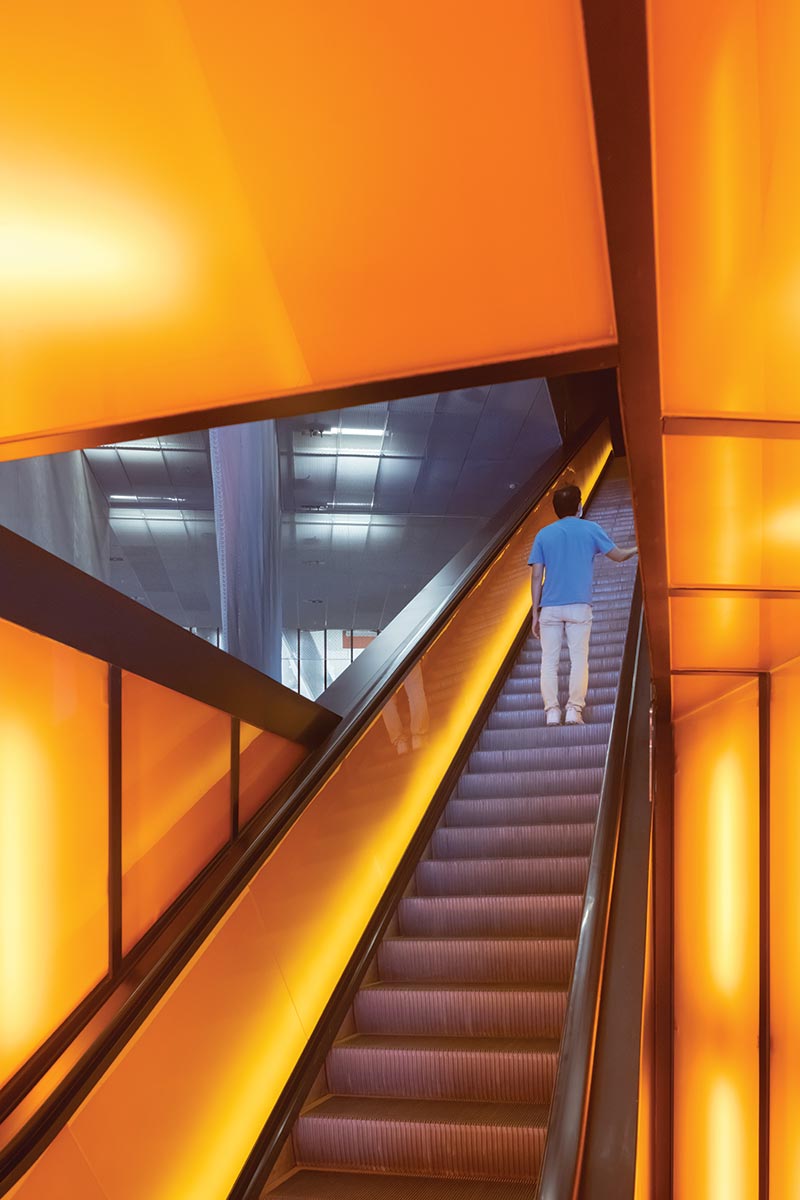
Photo © Iwan Baan
Escalators carry visitors to upper levels where they get a glimpse of backstage spaces.
One might ask whether, in diffusing the idea of theater, the building upstages the very performances it was built to house. But, come evening, as the sun sets and signs light up across Shilin, crowds of eager theatergoers can be seen moving slowly toward TPAC as if pulled in by the sphere’s gravitational force. And as you walk across the plaza—passing teenagers snacking and taking selfies—and as you ride the escalator up to have your ticket checked and then again, up farther, to the doors of the immersive blue theater, and at last settle into your seat, the old excitement of going out for a show returns in full force. Then the lights go down, the curtain rises, and this revolutionary building disappears, as it should.
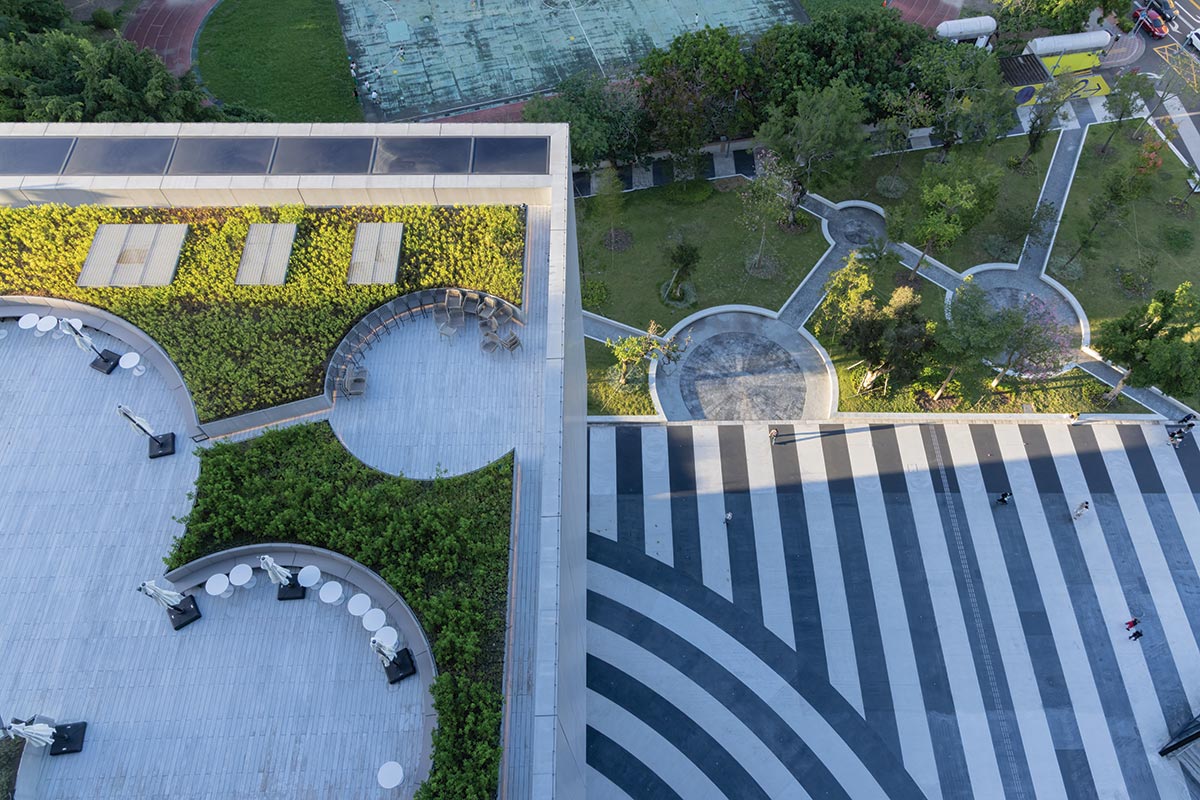
Photo © Iwan Baan
A terrace (above) is connected to a seventhfloor restaurant, while a top-floor outdoor viewing platform (below) is part of the public circulation route that winds its way through TPAC.
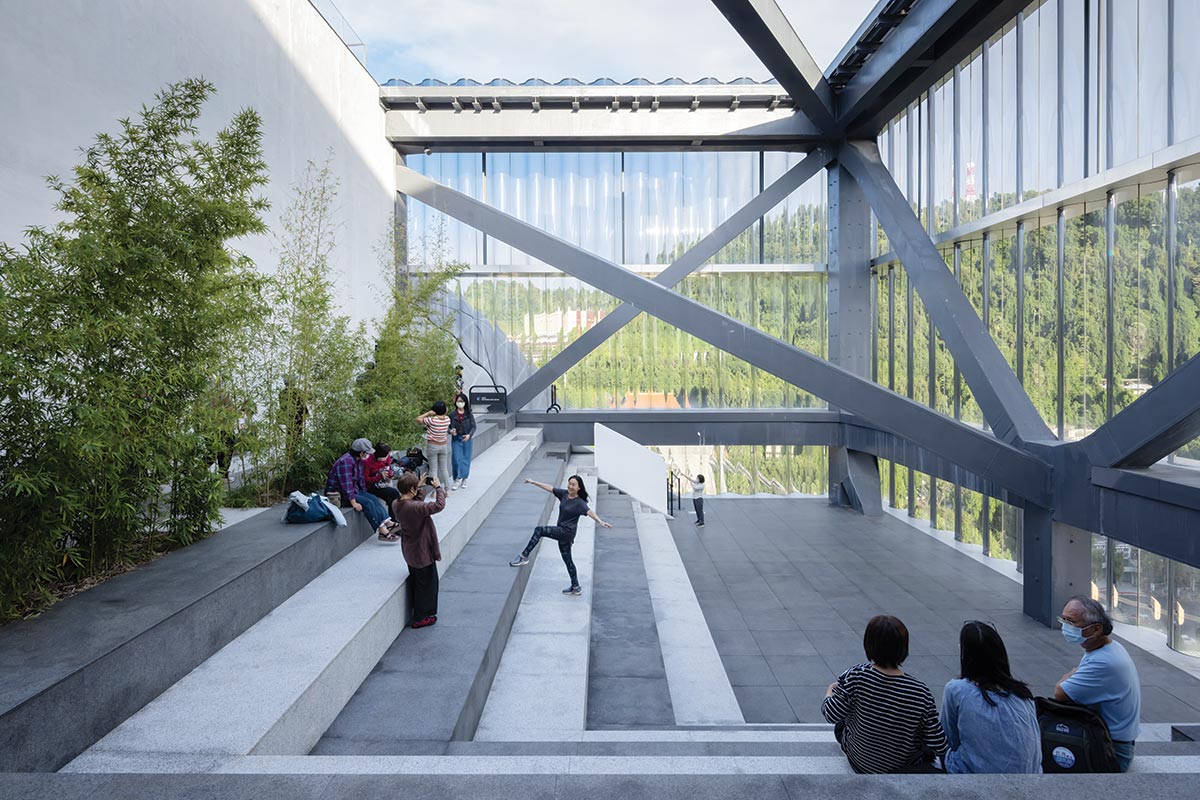
Photo © Iwan Baan
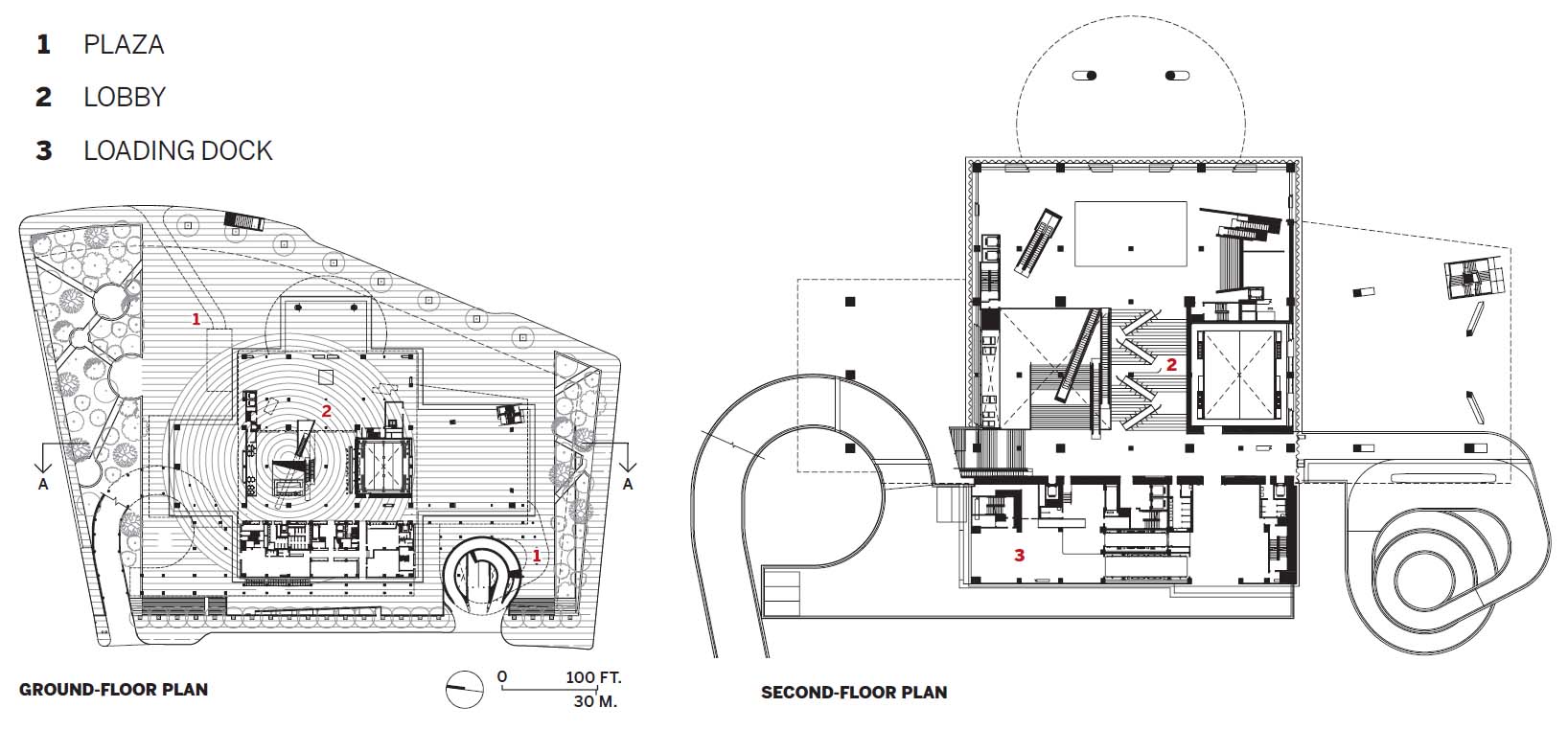
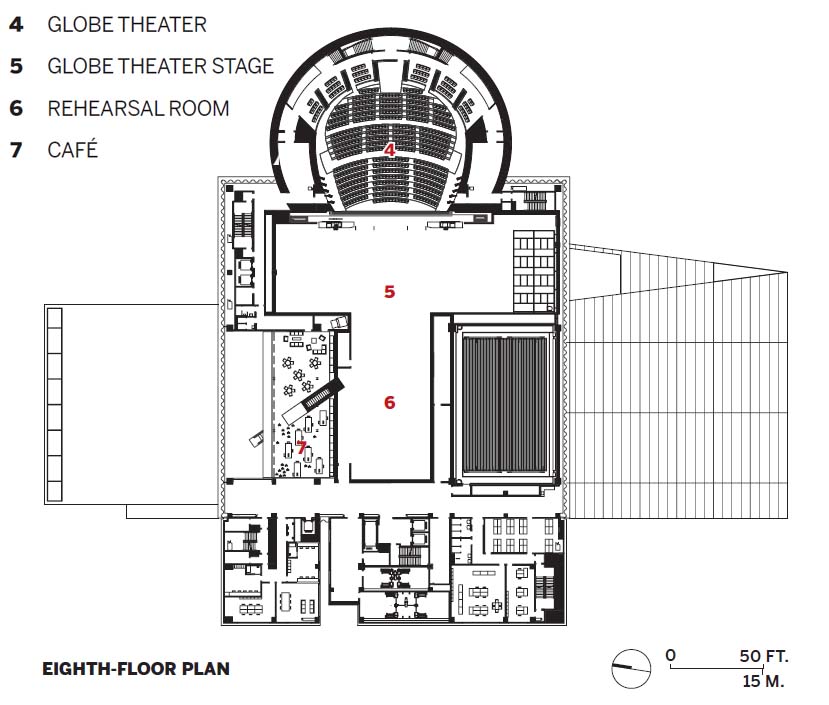
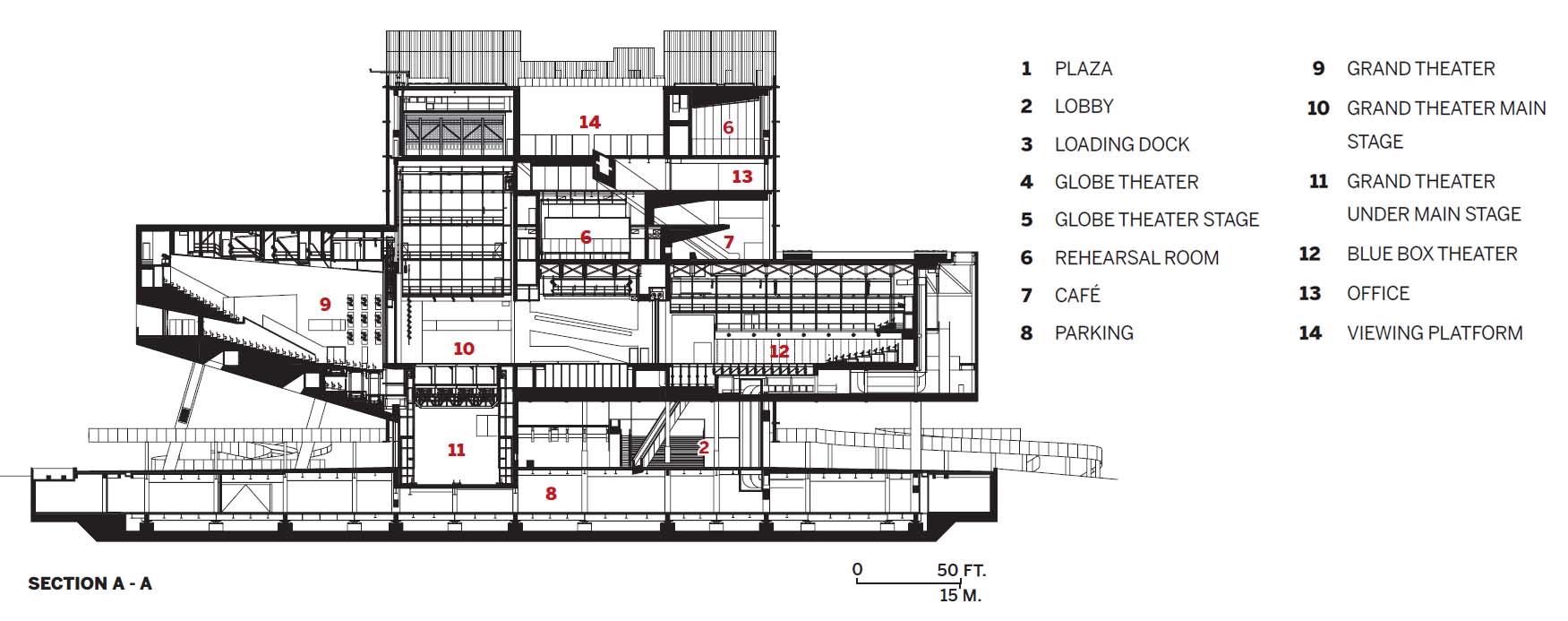

Credits
Architect: OMA — Rem Koolhaas, David Gianotten, partners in charge
Executive Architect: KRIS YAO | ARTECH
Engineers: Arup (structure, m/e/p, building physics, fire); Evergreen Consulting Engineering (structure); Heng Kai, IS Leng and Associates Engineers (building services); Taiwan Fire Safety Consulting (fire)
Consultants: dUCKS Scéno, Creative Solution Integration (theater); Royal HaskoningDHV, Theo Raijmakers, SM&W (acoustics); Chroma 33 (lighting); ABT, CDC (facades); Segreene Design and Consulting (sustainability); CNHW (landscape);
Contractors: International Engineering & Construction (former general contractor); Sun-Sea Construction (facades); Ancang Construction (interior and landscape); Jung Yan Interior Design & Decoration, Tech-Top Engineering (m/e/p, fire); Shiu Guan Machine Electric Engineering (AC); Jardine Schindler Lifts (elevators)
Client: Taipei City
Size: 630,000 square feet
Cost: $188 million
Completion date: July 2022












